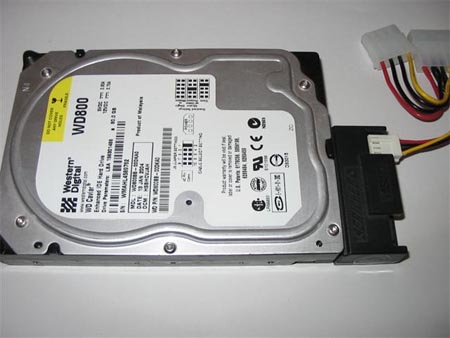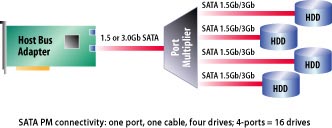Connecting up
Although SATA drives are not physically compatible with PATA devices, they support the same standards and as such they can communicate either through software (in your operating system) or with an adaptor like the one pictured below which converts a PATA drive for use with SATA cables.
SATA uses a point to point method of device connection and cables are limited to one device each, unlike PATA ribbons which can have 2 devices attached. The SATA host controller, however, is not limited in the same way as PATA controllers which can host a maximum of two devices as master and slave. To maximise the potential offered by the improved host controller port multipliers are available, a single cable is connected from the host controller to a port multiplier which can then connect up to 16 devices to a single controller giving the option of a huge storage capacity from a single host controller. For example, an enormous SATA RAID array is possible with minimal cabling using one of these multipliers seen below, diagram taken from http://www.sata-io.org

On the subject of cabling, SATA cables have another important advantage over their PATA cousins. The ribbon cables used for PATA devices suffer from a phenomenon called crosstalk. Even an 80 wire solution using alternating data and ground wires to supply additional shielding between data carrying wires causes problems as the resulting wires are so thin that interference can occur, slowing data transfer due to uneven signal propagation. There are a number of issues that can cause problems in signal transduction for a PATA device; these include crosstalk, ringing, ground bounce and clock skew. Due to improved electrical design and efficiency these problems are eliminated in SATA devices.









